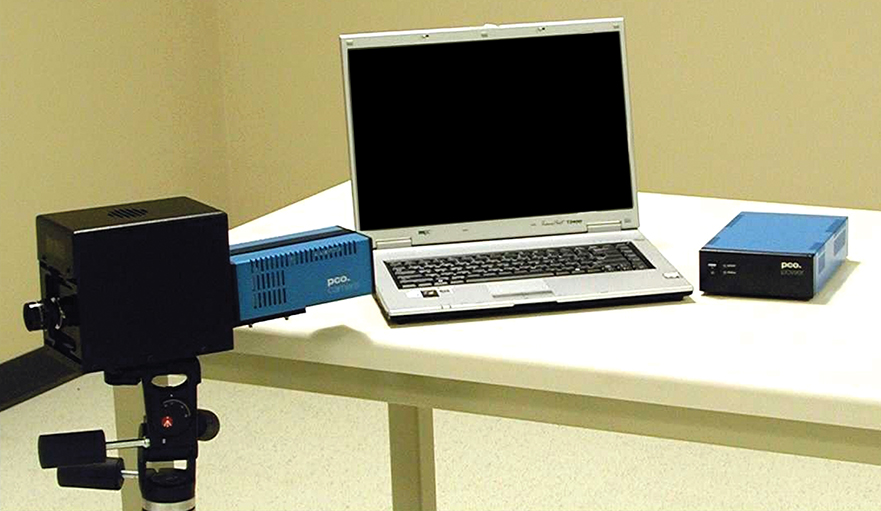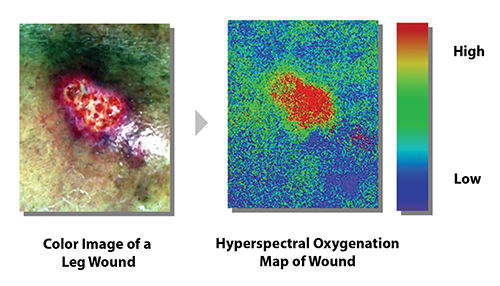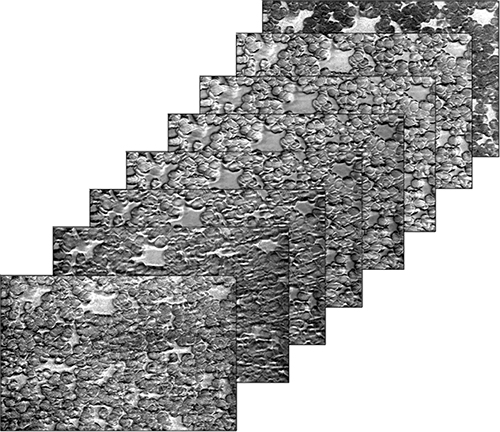
Portable Hyperspectral Imaging Broadens Sensing Horizons
Originating Technology/NASA Contribution
All objects reflect a certain amount of energy, even if it is just the electromagnetic energy created by the movement of electrically charged molecules. Measurements of these reflected energies, called spectra, can be used to create images of observed items and can thus serve to identify objects and substances. To create a spectral image, the intensity of the energy an object is reflecting is measured at different wavelengths, and then these measurements are assigned colors.
These images can be simple, as they often are with broadband or multispectral imaging, in which an image may consist of very few measurements. An example of this would be the type of pictures created by infrared or “night vision” equipment. This broadband multispectral imaging can be very helpful in showing differences in energy being radiated and is often employed by NASA satellites to monitor temperature and climate changes.
Images that are created with hundreds to thousands of spectra, hyperspectral images, allow for more subtle features to be shown, including the distinction between natural and man-made objects. Hyperspectral imaging is ideal for advanced laboratory uses, biomedical imaging, forensics, counter-terrorism, skin health, food safety, and Earth imaging.
Engineers at NASA’s Stennis Space Center work with the Institute for Technology Development (ITD), a nonprofit research company located onsite at Stennis, to develop new hyperspectral imaging technologies. ITD has been at the forefront of imaging technologies since it opened nearly 20 years ago, revolutionizing the fields of high-resolution imaging and measurement technology, with a focus on transferring this newfound technology to industry. Recent work led to reduced sensor sizes, elimination of the need for either the sensor or target to be in motion in order to obtain images, and the development of a portable hyperspectral imaging device applicable for a wide variety of uses.
Partnership
The portable device created by the NASA-ITD partnership was licensed, and in 2003, a new spinoff company, Photon Industries Inc., was formed. In 2005, ITD and its start-up brought the technology and business plan to the World Technologies Venture Capital Exposition, held that year in Texas, where it was discovered by Lextel Intelligence Systems LLC, of Jackson, Mississippi. In November 2005, Lextel purchased the company and its cutting-edge NASA technology.
The acquisition was a great boon for the technology, as it now had access to worldwide marketing, and later that year, it was inducted into the Space Technology Hall of Fame, created by the Space Foundation, in cooperation with NASA, to increase public awareness of the benefits that result from space exploration programs and to encourage further innovation.
Product Outcome
Since the acquisition, in addition to winning awards, Lextel has also added new features to and expanded the applicability of the hyperspectral imaging systems. It has made advances in the size, usability, and cost of the instruments. The company now offers a suite of turnkey hyperspectral imaging systems based on the original NASA groundwork. It currently has four lines of hyperspectral imaging products: the EagleEye VNIR 100E, the EagleEye SWIR 100E, the EagleEye SWIR 200E, and the EagleEye UV 100E.
The EagleEye VNIR 100E spans the spectrum from the visible to infrared, measuring the reflected energy of the target at hundreds of narrow wavelengths. It incorporates a patented line-scanning technique that eliminates the need for relative movement between the target and the sensor, which eliminates the need for liquid crystal tunable filters, which suffer from relatively low throughput. The EagleEye uses a prism-grating prism to separate incoming light into component wavelengths, a method that loses less energy and is, therefore, especially useful in situations where high signal-to-noise ratios are important. Each image created by the VNIR 100E contains a complete reflectance spectrum from 400 to 1,000 nanometers for every picture element in the image.
The next product in Lextel’s suite of hyperspectral imaging instruments is the EagleEye SWIR 100E. Each image created by this device contains a complete reflectance spectrum from 900 to 1,700 nanometers for every picture element in the image.
The third product in the suite is the EagleEye SWIR 200E. Each image created by this device contains a complete reflectance spectrum from 1,000 to 2,500 nanometers for every picture element in the image.
Lextel’s fourth product is the EagleEye UV 100E, an instrument that will span the spectrum from ultraviolet to thermal infrared. With this instrument, the images contain a complete reflectance spectrum from 200 to 400 nanometers for every picture element in the image.
Lextel has distributors for these hyperspectral imaging instruments in the United States, Canada, Europe, China, Japan, and Israel. They are currently used worldwide for a wide variety of applications including medical, military, forensics, and food safety, to name just a few.
In March 2006, Lextel entered into an agreement with ITD and NASA to continue to improve upon the already advanced sensing systems. The three entities are currently working on methods for incorporating hyperspectral fluorescence into the instruments.
In November 2006, Lextel also entered into an agreement with Headwall Photonics Inc., of Fitchburg, Massachusetts, to build a product line based on the convex grating reflective spectrograph design. This will allow the worldwide customer base to have a choice between prism-grating prism systems or reflective-based systems. There will also be work between the two groups to incorporate their microspectrographs into Lextel’s next generation system, The Micro Intelligent Imaging System.

Color image of leg wound next to hyperspectral oxygenation map of the wound

Microscope slide examined using a hyperspectral imaging instrument.

Lextel Intelligence Systems LLC made advances in the size, usability, and cost of the NASA-developed portable hyperspectral imaging instruments. The company now offers a suite of turnkey hyperspectral imaging systems based on the original NASA groundwork.













